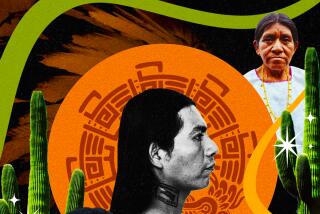India’s 400 Native Tribes Fight to Keep Their Cultural Identities : Asia: The people are descendants of the original inhabitants of the subcontinent before invaders began sweeping southward around 1500 BC.
- Share via
JAGI ROAD, India — Deep inside a leech-infested teakwood forest near a fast-moving stream, two men sit at a bamboo table poring over Oxford and Webster’s dictionaries.
The men are Tiwas, members of one of the 400 tribes in India, and they are writing the first dictionary of their language.
As Maheswar Patar, a former schoolteacher, and Uphing Maslai, a history buff, debate the intricacies of the language, two volunteers quietly fix them a dinner of rice and potatoes.
Another man cleans an oil lantern the scholars will need to work at night. A fourth member of the tribe gathers twigs to burn to keep mosquitoes away after dusk.
The tribes in India are descendants of the original inhabitants of the Indian subcontinent before invaders began sweeping southward from Central Asia around 1500 BC.
Many live in forests and wilderness areas and tend to be darker and shorter than average Indians. Many have Asian features.
With 69 million people--about 7% of India’s population--they are among the country’s poorest and most backward people.
Since India became independent in 1947, tribes people have been shunned, discriminated against and forced to give up hunting as forests shrank.
But they have been left alone in northeastern India, an area of high mountains, rivers and timberland north of Bangladesh. The area is attached to India only by a narrow strip of land known as “the chicken neck.”
India’s national newspapers and television stations rarely report about this area, and many Indians still regard it as primitive. For decades the government neglected its development.
But all that is beginning to change.
Today migrants from overpopulated India and Bangladesh are moving into the once-remote area. Businessmen and the government are investing there. Even satellite television is arriving.
These intrusions are threatening ancient ways of life, prompting some tribes to work hard to define and preserve everything from their black magic to their folklore.
“The tribals are going through a slow, but steady renaissance process,” said Chittattukalam Kuriala, a Roman Catholic priest who has worked with tribal groups in the northeast for 22 years.
For the Tiwa people in Assam, the largest and most developed state in the region, that means a dictionary.
“When we have this dictionary, our language will get some respectability and so will our tribe,” Patar said, pointing to the manuscript.
To make sure that it gets finished, the 350,000 Tiwas each contributed the equivalent of 15 cents to finance the project, even though most of them are illiterate. The work began toward the end of 1994 and Patar hopes to be finished soon.
“The Tiwas have found a nice way to show they want to preserve their identity,” said Mrigen Das, an official at the Tribal Research Institute in Gauhati, Assam’s capital.
In other areas of the northeast, tribes living in fertile, hilly areas are fighting to protect their land from hordes of Indians and Bangladeshis moving in from nearby plains.
That has spawned a half-dozen guerrilla wars for autonomy by some of India’s larger tribes. At least 5,000 people have been killed the past 10 years in the fighting between the tribes and Indian soldiers.
Tribes people are found in 22 of India’s 25 states, but are concentrated in the east. With 5 million members, the Gonds of Orissa are the largest tribe, and the Great Andamanis are the smallest, with only 19. Each main tribe has its own language or dialect. In the northeastern state of Arunachal Pradesh, which has less than 1 million people, 50 dialects are spoken.
In the northeast, some tribes also are trying to preserve traditions that many of India’s majority Hindus regard as odd.
Food, for instance.
“The tribals eat everything that moves,” said Kuriala, the priest. That includes caterpillars, dogs, snakes, grasshoppers, raw beetles and white ants.
Most of the tribes people are animists or were converted to Christianity years ago by missionaries.
Tiwas and Rihangs still follow a tradition that men work for free for three years in the houses of women they want to marry. In the Garo tribe, bridegrooms also “disappear” after their wedding has been fixed, many heading into the forest and others hiding in friends’ houses or in stores. The longer they can evade detection, the higher their standing in the community.
As their traditional livelihoods vanish, some tribes are starting their own businesses, often small farming cooperatives.
But for Patar, the author of the Tiwa dictionary, the tribes of India should first preserve their identity.
As he scribbled the Tiwa word for umbrella-- “chati” --a broad grin appeared on his face.
“We are almost there, only five more letters of the alphabet,” he said.
More to Read
Sign up for Essential California
The most important California stories and recommendations in your inbox every morning.
You may occasionally receive promotional content from the Los Angeles Times.













